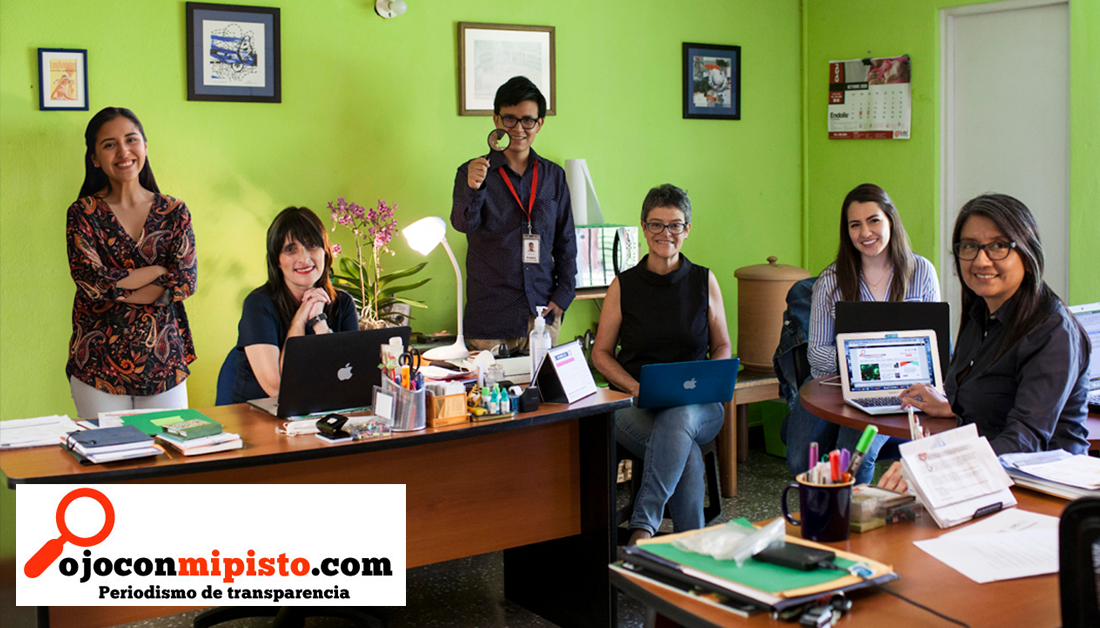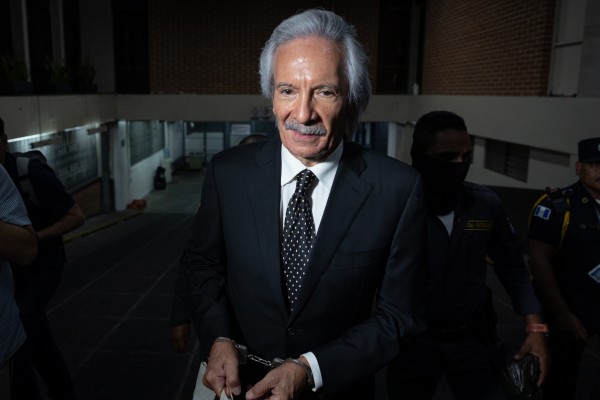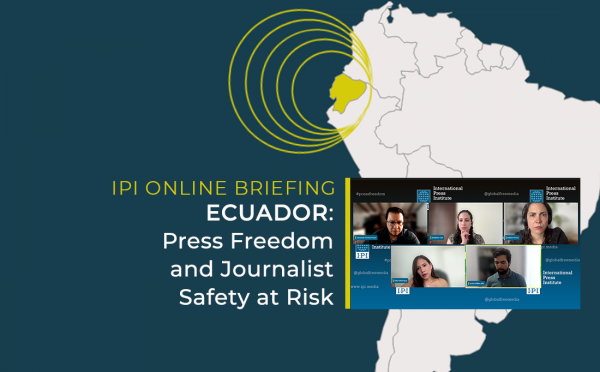Ojoconmipisto is a digital media project combining public spending surveillance, journalism education and citizen participation to create local political accountability.
The project was born out of Laboratorio de Medios in 2013 with its main aim to monitor public money in the municipalities of Guatemala.
Relying predominantly on grants, the organisation prioritises paying its contributors and focusing on local stories told by local reporters. Co-founder Ana Carolina Alpírez says she saw a gap in comprehensive local reporting after spending years working in newspapers. They would “send a reporter who would stay for three days, come back and tell the story but the local people would always tell us they fell short because that local insight was missing,” she says.
In Guatemala City, the core team is made up of six permanent staff, including an editor, two full-time reporters, a community manager, a journalist who administers and does the podcasts, and Ana Carolina. The rest is a network of freelance local journalists..
Aiming to reach younger readers between 25 and 35 across municipalities, Ojoconmipisto focuses on distributing news via social media networks, particularly Facebook. They also share podcasts detailing how they undertake investigations via Spotify, YouTube and Spreaker. They also count the municipal officers and oversight bodies, as well as other media, among their audience.
Ana Carolina Alpírez says their most important product is their training sessions. “The traditional media focus a lot on the big issues. So they are not seeing that corruption does not only happen in the big things, corruption starts in the small things, at a local level,” Alpírez says. “I think it is necessary to train local reporters. We are journalists and I do believe in training journalists. I also believe that the country really needs local journalists. So for me that is very important.”
She hopes through these training sessions, local journalists will be equipped to tackle what she describes as a “crisis” in journalism.
“There is a crisis in journalism… one is the crisis of sustainability and the other is disinformation. And we have a lot to do in both of them.”
Andres Schafer talked to Ana Carolina Alpírez at length about the journey of building Ojoconmipisto, their journalism mission, and the products and business model that is helping them deliver it.
The interview has been edited and condensed for clarity.
Schafer: What is Ojo Con Mi Pisto?
Alpíirez: Here in Guatemala, “pisto” is an everyday word for money. So, the name means “watch out for my money”, “watch out for my pisto”, “watch out for my taxes”. Ojoconmipisto was born December 6, 2013 with the aim to monitor where tax money is being spent at a local level within local municipalities.
Schafer: Could you explain a bit about the process of building the organisation?
Alpírez: Well, we were clear about what we wanted to do. The founders of Ojoconmipisto are journalists, and first we founded a communication company called Laboratorio de Medios in 2006. We generated the project called Ojoconmipisto which came out in 2013. It was clear based on our experience of working in a newspaper, that we had to be able to tell the stories from inside the local departments.
It’s the same issue for the media here in Guatemala City, where the headquarters of everything traditional is located. Moving a person to those departments was more expensive for them, so they did not do it. So it was with this idea that Ojoconmipisto was born.
We launched in 2013 with our first grant from the USAID program here in Guatemala focused on transparency. For us, journalism is a job and if we cannot pay our reporters for their articles, we will not ask for them.
In 2014 with another grant we started our first data research and generated a database with the names of all the members of the municipal councils and the projects that the municipalities were working in that year as a consultation tool. From that investigation, we identified a specific case of a mayor and a congresswoman who sold services to the State as suppliers, which is prohibited by law.

Ojo com mi Pisto’s investigation uncovering two municipal representatives benefitting from public procurement
As a company, Laboratorio de Medios provides consulting and training. From that year on, we identified what I would say is our most important product at the company level, which is the training of reporters, who all have the obligation and the commitment to generate a news article from his or her municipality on the topic that was discussed that day.
The team we have today is the editor, the community manager and the two full-time reporters here and we continue to work with the correspondents.
Schafer: So how would you describe what makes your product innovative?
Alpírez: Definitely the municipal emphasis and the editorial support we give to reporters.
I mean, before working here at Ojoconmipisto, I worked at a newspaper and I was editor-in-chief. Editors from other newspapers would complain about the lack of preparation of a correspondent and say, “I get the article and I have to redo the whole thing.” Well, I tell him “why don’t you train him?” “It would just take me too long.” Then I talk to the correspondent and he would complain that he sends his article and that they edit it without saying anything to him. So I tell both what if they would work together? I know it takes time to train people.. But after you train them, they start to grow and walk on their own. But in general, they don’t do that. So, that is very important to me. These reporters, when they are with us, have to commit to replicate in their workplaces what they learn with us. I think that’s another part of it, it’s something different that we do.
We also generated a space for citizen participation. Our principles are threefold. Municipal oversight, training and citizen participation. We are very interested in this part of citizen training. Why? Because they are that first source of information, they are the ones on the ground. Once a month we have a program called the Neighborhood Guide. We make an open call, it is a closed activity and people sign up. Next month we are going to talk about the Municipal Code. The following month on the Access to Public Information Law. On average, a group of 35 people participate and the curious thing is that more than 60% of the participants do not live in Guatemala City.
Schafer: So, who makes up the team since it is so locally focused?
Alpírez: We have two teams. In Guatemala City, we are the core team made up of an editor, two full-time reporters, a community manager, a journalist who administers and does the podcasts, and myself. There are six of us. And we rely on the work of a network of local reporters. This network of reporters is paid per story when a story is published. A strength of the project is that we give our reporters editorial support and training and with this, we have regular correspondents who always work with us and others who work only for a particular story.
Schafer: And how have you supported the organisation financially? Do you have any other revenue streams besides grants?
Alpírez: The first project was funded by USAID. Now, more or less, I would say that 90% is coming from the grants and 10% we generate through Laboratorio de Medios.
Schafer: What do you see as the main purpose of the organisation? And who is your audience?
Alpírez: The idea is to use journalism to create accountability within systems at a local level.
We have two types of audiences. One audience is public officials of the municipalities themselves: when they see that someone is auditing them, they start to pay a lot of attention. In this group, I also include institutions, for example, the Comptroller General’s Office, the Public Prosecutor’s Office, which do not have enough personnel. They monitor us to see what issues we are bringing up and what catches their attention or gives them any red flags, etc.
Now, as for our followers, readers or users, these are urban, we are directed to the whole country and we also write for the other reporters, the ones here in Guatemala City, because when we started we didn’t audit Guatemala City since it was something that the traditional media were doing here. Today we audit Guatemala City because the traditional media don’t do that anymore.
Our readership is between 25 and 35 years old. Half are men and half are women in the urban areas. We don’t work in Mayan languages, which is a major limitation. We work in Spanish.
Schafer: Do you have a sense of how the audience has grown over the years from 2013 to now and whether the composition has varied or remained more or less stable?
Alpírez: Look, we have grown, I use as indicators the number of visits to the page since we started, as well as the following in social networks, (to see) if we have grown in the community. The growth has been organic in all media and we are growing little by little.
This year, we did a pilot project. We started to scrutinise a subject that the media does not scrutinise. And that is sports. Here in Guatemala, federated sport receives a state subsidy.
According to the law, 1.5% of the state’s annual income goes to federal sport. We used our own funding from the Laboratorio to carry out this project. It is a data journalism project and we wanted to see how we could reach new audiences.
We monitored the use of these funds, and published all this as a special investigation before the Olympics and during the Olympics. And it did indeed increase our number of followers and readers.
So one thing we would like to do is to have a journalist to scrutinise sports, which generates passions. And through the monitoring of sports, these fans can be led to the municipal information. This is something we want to work on.
We just published another investigation from our own resources, related to the Guatemalan Literature Nobel Prize 1967. As with the sports investigation, we are looking for new audiences.
¿Por qué se ganó Miguel Ángel Asturias el Nobel en 1967?🤔 Aunque su calidad literaria sí tuvo mucho que ver, @moreno_deleon, editor de @el_Periodico, nos explica más sobre la dinámica de los galardones para entender por qué Asturias.#ExpedienteNobel67👇https://t.co/Ydjgl5AbQL pic.twitter.com/Rm61PdE5Sc
— Ojoconmipisto (@_ojoconmipisto) December 13, 2021
Schafer: How do you understand and build credibility with your audience?
Alpírez: We use social networks. The first network is Facebook. Then follows Twitter, Instagram, we’re even working on podcasts as well. We have a monthly newsletter where we tell people what the current month was like and what activities we have for the next one. And we participate in radio programs when we have the chance. It is interesting, we have more backing, more support from radio stations in general than from other press or television media. The material we publish can thus be replicated. The only thing we ask for is credit. We’re on Spreaker, we’re on YouTube and we’re also on Spotify. That’s how we work.
We are rigorous in our processes. We are listening to our readers. The main door is Facebook, where messages come in. Messages also come in through Twitter. We receive some calls to the site.
And you also realize how the credibility of the media is growing when you start receiving inquiries from other municipalities that we have not covered yet, but people are already communicating with you. That is one part and the other part is that the site is already a reference for other colleagues.
Schafer: And what has been the greatest challenge?
Alpírez: I was trying to find funding here locally in Guatemala. Everyone told me what a great project this is but they wouldn’t give me funding. Something that limited us in the beginning was that since we are a limited company, most of the funding you get from international organisations is aimed at NGOs or civil associations. So we had to learn to work under that scheme.
I think that has been the greatest challenge we have had in financing and looking for sustainability.
The second challenge we have had to overcome is the difference between practicing journalism here in Guatemala City in the established media, and another thing is that you go to the departments and see how the media works there. It’s another structure. Many of these media may be owned, for example, by the mayor, or a member of the Congress. The other thing is professional training. There is a difference between the training that a journalist or reporter may have here in the city to one in the province. You also find cases of journalists who work in a public institution and are also reporters, for example. So, as we have been overcoming those obstacles little by little, I think what is more important than anything else is what we do to train those departmental reporters.
One of the obstacles I have is that we need a bigger team to really be able to cover more municipalities and serve more people. We have now two reporters in the network. And I feel that we need more people to be able to continue working.
Schafer: What plans do you have now for Ojoconmipisto? And how do you see the future of journalism? Are you optimistic?
Alpírez: Yes, we have a business plan we are working on. I want to start looking at how I can sell advertising on the site, for example, to generate other income. That’s one part of sustainability. And the other thing is we also want to increase our work with the Laboratorio de Medios to be able to generate more funding for the Ojoconmipisto project. We are working along these lines at the moment.
I am optimistic, I do believe that we will be able to continue working. My most immediate challenge right now is to start preparing for the next election coverage, because the mayors will be changed.
So how are we going to cover these elections? What were the lessons learned from the last process? We documented all the obstacles we had to work around, what response we had in the municipalities, and then we participated in a series of roundtable discussions convened by the Supreme Electoral Tribunal, which by law, when an electoral process ends, calls for an open meeting to review what happened.
My aspiration is: get more funding to be able to do these things I’m talking about. And also something that is very important: we need journalism. What we are doing is important. There are two crises, one is the crisis of sustainability. And the other one is this misinformation crisis. And we have a lot to do in both areas.
This story is part of IPI’s Local Journalism Project. IPI’s work mapping, networking and supporting quality innovative media serving local communities is supported by the Friedrich Naumann Foundation and Craig Newmark Philanthropies.



